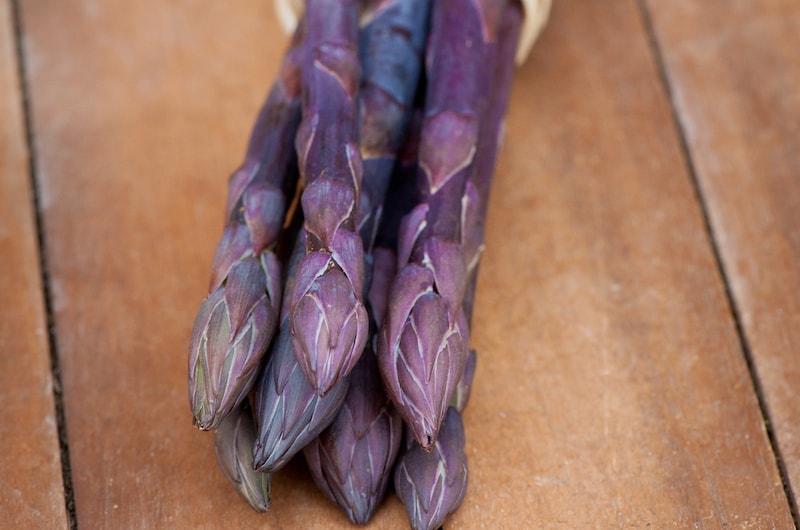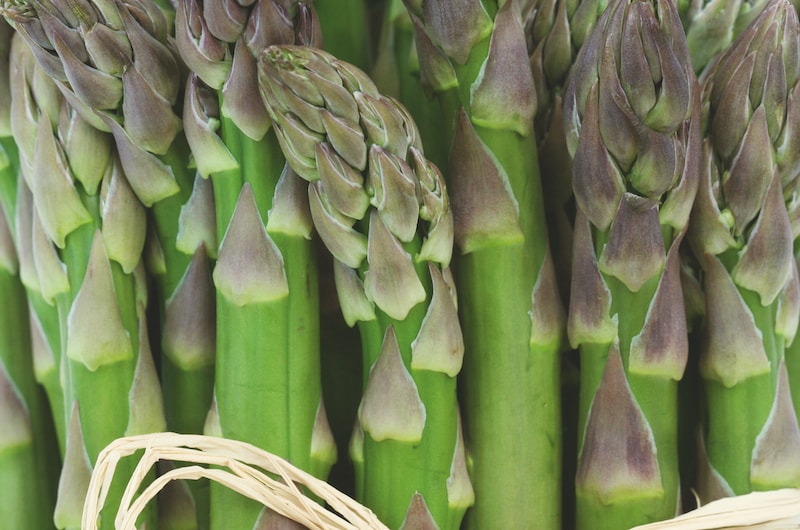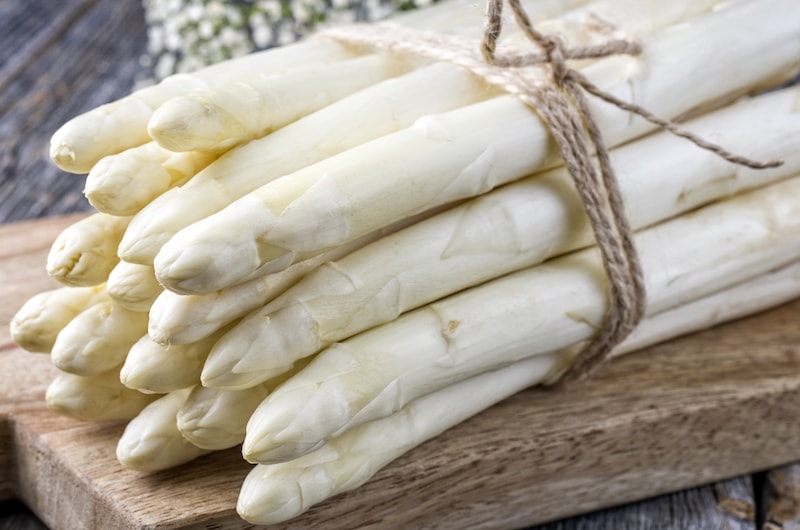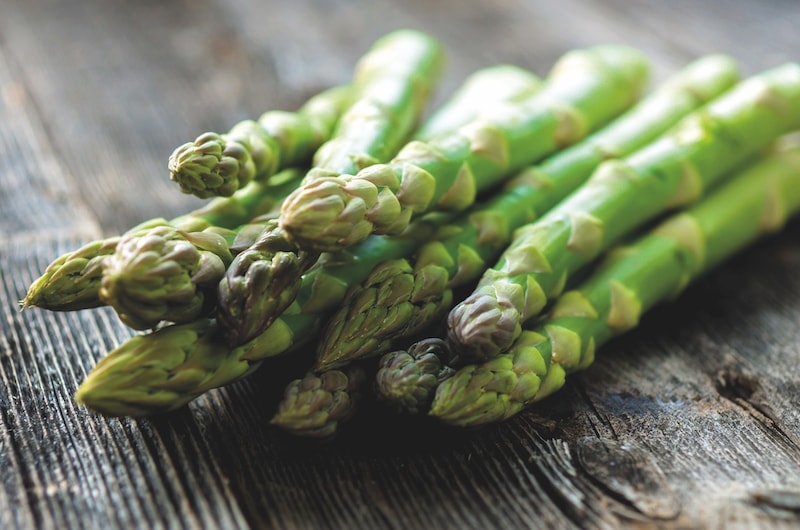If you fancy growing asparagus at home or on your allotment and you’re looking for a little advice to get you started, this is where you’ll find it. Here are some of the best articles, videos and Instagram posts to help you plant, care for, and harvest your asparagus at the optimum times. Here’s everything you need to know to successfully grow this delicious perennial vegetable.
Contents:
- Best advice on sowing asparagus seeds
- Best advice on planting asparagus crowns
- Best advice on growing and caring for asparagus
- Best advice on asparagus pests and diseases
- Best advice on harvesting asparagus
Best advice on sowing asparagus seeds

Image: Asparagus Seeds ‘F1 Ariane’ from Suttons
Growing asparagus takes time – in fact, if you’re growing from seed, you shouldn’t harvest for the first three seasons (two if you’re planting crowns). But don’t let that put you off because, as the horticultural team at Sutton’s blog say, “a well-managed asparagus bed should remain productive for up to 20 years or longer.” For a comprehensive growing guide, check out our article: Growing Asparagus: A Simple Guide to Planting & Harvesting.
“Asparagus seeds germinate best when given consistent temperatures between 24-30ºC,” says Alina Jumabhoy at DIY Garden. A propagator placed on a heating pad is the best way to achieve this, but even then, you must be patient because these seeds can take anywhere from 2-10 weeks to germinate. For this reason, Alina recommends starting them early in January or February.
Before you plant out your asparagus seedlings, watch Claire’s video over at YouTube channel, Claire’s Allotment. Here she gives an excellent demonstration of how to plant asparagus properly, beginning with digging a trench and filling the bottom with organic matter, through to getting your young plants into the ground.
Best advice on planting asparagus crowns

Image: Asparagus officinalis ‘Pacific Purple’ from Suttons
“A raised bed is considered the best method of cultivating asparagus,” says John Harrison at Allotment & Gardens. John, whose knowledgeable advice comes highly recommended, explains that asparagus prefers well-drained, sandy soil. However, if you garden in heavier, clay soils, he recommends improving the soil first “with plenty of humus and some grit or sand to aid drainage.”
Whether you’re planting seedlings or growing asparagus from crowns, preparation is key. As Stephanie Donaldson at The Enduring Gardener says in her excellent blog post: “You must eradicate these weeds before you even think of planting – otherwise, once the crowns are in position, you’ll be unable to do anything other than superficial weeding for fear of damaging them.”
Over at Charles Dowding’s blog, the no-dig expert believes the initial investment in good quality crowns is well worth the price tag because your asparagus bed will be with you for a long time. He recommends going for all male hybrids which put more effort into growing spears, than females which prioritise fruiting. For an idea of the amount of space you’ll need to create a high yielding asparagus bed, Charles’ video is a must. His 9m long patch yielded 15.5kg of spears in its fifth year.
Best advice on growing and caring for asparagus

Image: Asparagus ‘Gijnlim’ from Suttons
For keeping weeds down, retaining moisture in the soil, and adding nutrients, mulching is a must for every asparagus grower. Over @theoldgranarygardens, you’ll see just how it’s done – even when you leave things a little late. Here’s proof that you can still mulch even after the first few spears have been harvested. As this Cornwall-based Instagrammer says, the asparagus will be much happier for it.
Wondering when you can clear your asparagus ferns away? “As soon as it goes yellow, it can come down,” says Penny Foxwell @plotandpantry. Then it’s time to weed before applying “a really thick mulch of composted manure to feed the plants over the winter.” Penny says, “as I cut it down I’m filled with gratitude as I look forward to buckets of tasty spears to pick for at least six weeks from next May.”
If you inherit an old asparagus bed, you may find it’s congested with self-seeded plants and a little surgery may be necessary. Here Kate @ditchlingediblegarden decides to dig her 15-year-old asparagus up and sort it out. Next, she plans to “add sand for drainage (on heavy clay) & well rotted manure & replant the best looking crowns giving them lots of space & hope they survive the transplant shock.” Follow her feed to see if Kate succeeds.
Best advice on asparagus pests and diseases

Image: Asparagus ‘Vittorio’ from Suttons
Asparagus is easy to grow and care for but asparagus beetles can be a problem. For natural ways to deal with them, head over to Steve Jones’ Growing Guides. He says: “Asparagus beetles don’t like tomato plants so growing tomatoes in the same bed will not only utilise the space but also keep your asparagus plants healthy.” Check out his post for some excellent companion planting suggestions to help suppress weeds.
If you’re lucky enough to keep free-range chickens, keep an eye on your feathered friends or you may find your precious asparagus crop ends up in their bellies rather than served alongside one of their delicious fresh eggs. To find out how to protect asparagus from chickens and pigeons, head over to @londontolandgirl where Catherine Hackett shows you what to do.
Best advice on harvesting asparagus

Image: Claire’s Allotment
Asparagus needs time to establish so you mustn’t harvest for at least the first year, and usually two if you’re growing crowns. If you grow from seed this is extended to three. However, opinions do vary and over at Simplify Gardening, Tony O’Neill reckons it’s OK to take up to 50% the second year – as long as you don’t overdo it. Wait for year three for your first full harvest.
For a demonstration of how to carefully cut asparagus spears just below the soil surface, head over to Claire’s Allotment where the lady herself shows just how it’s done. Claire says you’ll need a sharp knife so you don’t damage the surrounding shoots.
For an alternative way to harvest asparagus, Charles Dowding recommends snapping your spears rather than cutting. As he demonstrates, this method is quicker and may even be more effective than harvesting with a knife. He says that when you bend the stem, you get a sense of where it will break, avoiding the woody part which isn’t particularly nice to eat.
If, having harvested your first asparagus spears, you’re looking for the very best way to cook and enjoy them, we recommend heading over to The Seasonal Table where bloggers Tom and Kathy share their favourite recipe. They say, “high heat, a dribble of olive oil, a grinding of black pepper and some crumbled flakes of sea salt is all they need.” Do as they do and serve your asparagus with crusty bread, soft boiled eggs and a squeeze of lemon. Yum.
Asparagus takes a little bit of patience to get it started, but once you’ve made the initial investment of time and effort, you’ll enjoy decades of delicious, healthy harvests. We can’t wait to see how you get on!
Last Updated on November 8, 2024 by Suttons Horticultural Team




